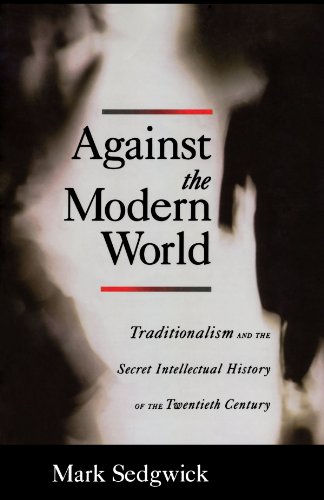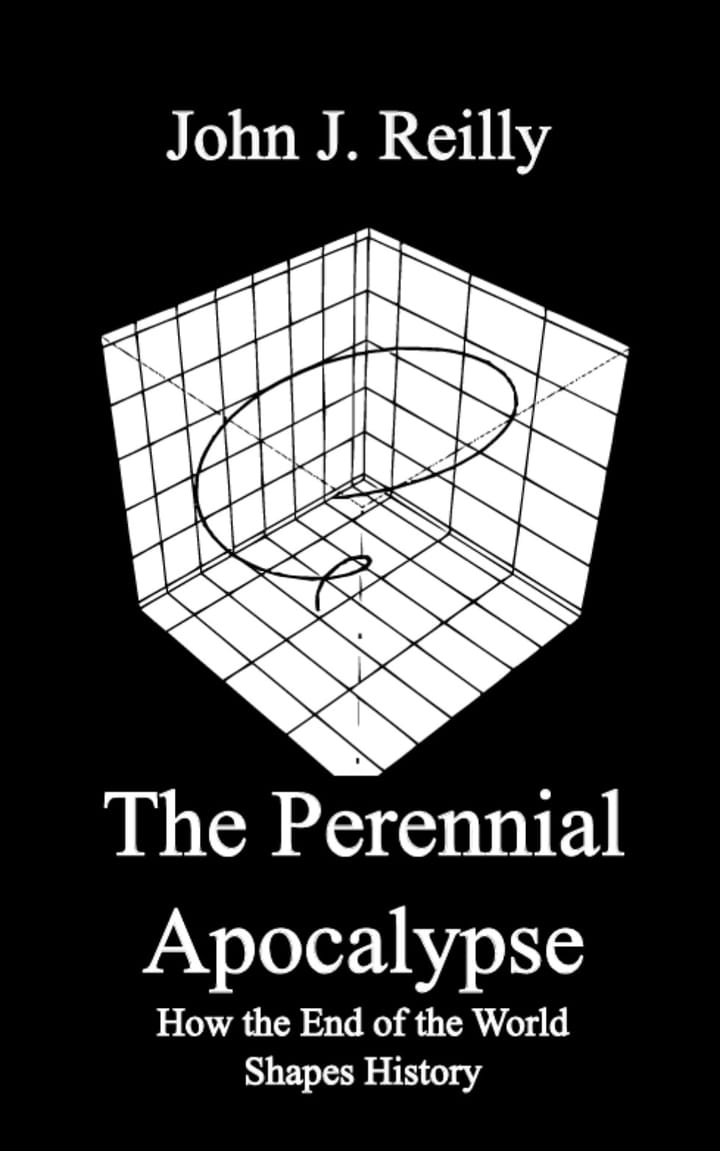The Long View: Against the Modern World
This book review is part of the reason I distrust Religious Studies departments. Anything influenced by Evola and Guénon probably bears close watching. John's warning here is pretty important in the post 9/11 era as well:
If you've been reading about Islam in English, you have probably been reading material heavily influenced by Traditionalism. The discipline of "religious studies" was largely founded by "soft Traditionalists."
It is always hard to come at a religious tradition from the outside. The relatively unknown ideology of Tradition makes that even harder.
I've been following Tradition for fifteen years now. As John says, there is a danger in thinking this movement stronger and more prevalent than it actually is. However, the alt-right, much in the news of late, really is influenced by Tradition. Or at least a small number of relatively uninfluential Twitterati are. The broader populist political movements in the West are not. Even the Russians don't pay much attention to Tradition.
I've also often felt relieved that Guénon deemed Catholicism [Christianity in general really, but he was from France] unsuitable ground for Tradition. Like John, and other authors who have studied Tradition, I find something intriguing about the idea, but at root, it seems wicked and perverse. Some seeds fall on on stony ground.
Against the Modern World:
Traditionalism and the Secret Intellectual History of the Twentieth Century
By Mark Sedgwick
Oxford University Press, 2004
370 Pages, $35.00
ISBN 0-19-515297-2
Companion Website: www.traditionalists.org
“Some theories which he may meet in modern Christian circles may prove helpful here; theories, I mean, that place the hope of society in some inner ring of 'clerks,' some trained minority of theocrats. It is no affair of yours whether those theories are true or false; the great thing is to make Christianity a mystery religion in which he feels himself one of the initiates.”
--C.S. Lewis
The Screwtape Letters
This general history of the Traditionalist movement starts with the author in a smoldering building in Moscow, wondering whether the security services had just tried to burn out his borrowed apartment in order to impede his investigation of the Tradition-influenced National Bolshevik Party. As a matter of fact, they hadn't, and the National Bolshevik Party turned out to be more a political performance-art ensemble than a serious political party. Still, anyone who has tried to assess the place of Traditionalism in 20th-century intellectual history has probably experienced something like his mild paranoia.
If you've been reading about Islam in English, you have probably been reading material heavily influenced by Traditionalism. The discipline of "religious studies" was largely founded by "soft Traditionalists." That is also true of some fields of anthropology, particularly regarding the Plains Indians. The paranoia sets in when you learn there is good reason to look for Traditionalism in the works of an apparently endless list of authors, including Thomas Merton, T.S. Eliot, and E.F. Schumacher. (Prince Charles is involved, too, a little.) The fact that some academic Traditionalists take care not to cite their Traditionalist sources only adds to the impression of a vast, shadowy network that includes everyone in the world but you.
Happily, this sober survey does not spin conspiracy theories. It also does not make the mistake of overestimating its subject, a movement that is important but not central to understanding the last century. The author, Mark Sedgwick, is a young British scholar at the American University in Cairo. He encountered Traditionalism while studying the spread of semi-secret Sufi orders among Westerners, a process that began in the early 20th century. From there, the study spread to mutations in French Freemasonry, to the development of the theory of esoteric fascism, and then to the nihilist political violence of the 1960s and '70s. The story goes on to Eurasianism, which is an anti-Western but increasingly respectable school of thought in Russia, and to the effects of Traditionalism on Islamism and on the politics of non-Arab Muslim countries.
In addition to paranoia, one of the dangers of studying Traditionalism is that you soon bite off more than you can chew. The only flaw I find in this book is that it does not cover nearly enough. Also, a note on nomenclature: self-identified Traditionalists generally refer to their system in print as "Tradition" or "tradition." However, this survey settled on "Traditionalism," so this reviewer is not going to argue.
Traditionalism is firmly rooted in Western hermeticism. Its most important element, "perennialism," may be traced to Marsilio Ficino (1433-1499) of the Platonic Academy of Florence, who developed the hypothesis of the "philosophia perennis." (The term was coined later, though: Sedgwick credits Agostino Steuco at around 1540; Aldous Huxley, in The Perennial Philosophy, credits Leibnitz.) Ficino used the "Corpus Hermeticum," a venerable collection of neoplatonic texts, to argue that a primordial metaphysical basis lies behind all the world's major religions, which could therefore be said to be transcendentally united.
The problem was that the "Corpus Hermeticum" was not as venerable as the Renaissance thought. In the early 17th century, it was proven that the "Corpus" dates from the early centuries of the first millennium, and not from ancient Egyptian times, as had been supposed. Thus, it no longer seemed so remarkable that the texts contained Platonic and even Christian elements. Still, though Ficino's arguments for perennialism had been discredited, the idea never entirely went away. It received new support in the 19th century, when the availability of Vedanta texts made it possible to argue for metaphysical universals on a cross-cultural basis.
That was where René Guénon (1886-1951) came in. Traditionalism was his creation, and its history is largely the tale of his influence. The son of an ordinary French bourgeois Catholic family, he wandered from what otherwise might have been a conventional teaching career into Indic studies and thence into the occult milieu of the Belle Époque. His Traditionalism was a reaction to the Theosophy and spiritualism of the time, though a disinterested observer might be forgiven for concluding that it is simply another school of the same sort.
To the principle of perennialism, Guénon made two powerful additions. One was the principle of “initiation.” This meant that spiritual advancement required a direct link to the supernatural, which usually meant induction into a chain of adepts going back to some historical source of power. In his occult phase, which lasted until about 1920, Guénon was initiated into no fewer than six Masonic or mystical groups. One of these was the Sufi order, the Shadhiliyya Arabiyya. Guénon took the Arabic name “Abd al-Wahid.” Sedgwick insists this initiation was not a conversion; certainly Guénon did not begin to live as a Muslim for another decade.
One of the most important consequences of the principle of initiation was a tendency toward “vanguardism” (a term Sedgwick does not use). Traditionalism sought to create an elite, sometimes thought of as a saving remnant of the Western world. Traditionalism differs from Theosophy and other occult sects in that it has never sought a mass audience. In practical terms, this meant that Traditionalism expressed itself in Masonic groups and other semi-secret societies. When it took the form of Sufi orders, it often turned them into clandestine organizations, which is not how Sufism works in Muslim countries.
Guénon's second innovation was “inversion,” the principle that all the change in the Western world since medieval times was for the worse, indeed that all historical change is a decline. What the West thinks of as progress is really decay, leading to an inevitable collapse. Guénon defined modernity in terms of the privation of the good: “If everyone understood what the modern world was, it would immediately cease to exist.” Inversion gave Traditionalism its apocalyptic content. In some contexts, it gave Traditionalism revolutionary potential, as adepts sought to hasten the end of modernity.
When discussing Traditionalism, there is always the danger of attributing to Guénon projects that were really worked out in detail only by his followers. Still, it does not falsify his system to say that his general intent was to create an order of persons who could make the West a Traditional civilization again, either by arresting its decay or rebuilding it on Traditional lines after its collapse. The most interesting constraint on this ambition was Guenon's rejection of Christianity in general and the Catholic Church in particular as a possible basis for reconstruction. He sometimes wavered on this point, and there have always been Christian Traditionalists; in Paris, Guénon is still a “Catholic” author. Generally, though, Guénon argued that the chain of initiation had been irremediably broken in the Catholic Church. Thus, the true Tradition was to be sought in Vedanta, Sufism, Freemasonry, Taoism, or even High Paganism, but not in the public spiritual heritage of the West.
If Sedgwick is to be believed, one of the key inflections in the development of Traditionalism, the turn toward Islam, was an accident. Guénon's metaphysical point of reference was always Vedanta. Nonetheless, in the 1920s, when he wrote his principal books, Guénon seemed to be just a slightly eccentric Catholic intellectual. (His most-cited books, incidentally, are The Crisis of the Modern World (1927) and The Reign of Quantity and the Signs of the Times (1945).), He attended Mass regularly with his devout wife. For a time, he lectured at the Catholic Institute in Paris, where he was a protégé of Jacques Maritain. He did get into increasing trouble for declining to acknowledge Catholicism as the fullest expression of the truth, and he was quite capable of equating the Third Eye of Shiva with the Sacred Heart of Jesus. In any case, after his wife's unexpected death at the end of the decade, Guénon made an unsuccessful business trip to Egypt. Perhaps simply because it was cheaper, he remained in Cairo, and took up the life of a Muslim. He started a new family. He did not abandon his perennialism, but thereafter advised his growing cadre of followers of the necessity to observe the full practice of one of the great Traditions, as he observed the Sharia.
The spread of Sufism in the West during the 20th century is a tale in itself, one that intersects only at points with Traditionalism. Sedgwick names Robert Graves as a Sufi, for instance, though apparently not of a Traditionalist order. (I would suggest that Graves's novel, “Seven Days in New Crete,” actually expresses the Traditionalist agenda quite well, but there's the paranoia again.) Rudolf Freiherr von Sebottendorf, the alchemist and numerologist who managed the Thule Society in Munich in the 1920s and who founded the party that eventually became the Nazi Party, was also a Sufi, but again, not a Traditionalist. (Hitler was neither, by the way.) There is even something called “Neo-Sufism,” which divorces Sufi initiation from Islam entirely.
By far the most important Sufi in Traditionalist history was Frithjof Schuon (1907-1998), a man of complicated Franco-German parentage who acquired Swiss citizenship, but finally created a sort of commune in Bloomington, Indiana. Guénon seems to have entertained high hopes that Schuon's Alawiyya order (later the Maryamiyya order), then based in Switzerland, would develop a way to indigenize Traditionalism in Europe. That might spare the old continent the indignity of eventually being culturally annexed by alien Islamic societies. Schuon's version of Traditionalism had its own trajectory, however.
Schuon rejected Guénon's position that Christianity had lost the power of initiation: both baptism and confirmation really were the initiations they claimed to be, in his estimation. Schuon, in fact, is among the best-known exponents of the transcendental unity of religions. However, he went beyond perennialism to something like universalism, which mixes and matches elements of the major Traditions: a grave error for most Traditionalists. Moreover, he seemed to acquiesce in the belief among his followers that the Traditions were united, not just primordially, but in himself. In any case, he had considerable effect on several academic disciplines. His keen interest in Native Americans, for instance, ensured that friendly anthropologists would write about Black Elk from a Traditionalist perspective.
Traditionalism has often sought political influence, and not without success. For instance, the Iron Guard in Romania, which supported the alliance with Nazi Germany, grew out of a sophisticated Christian Traditionalist movement, the Legion of the Archangel Michael. Mircea Eliade famously supported the Legion, though he distanced himself as the movement became less spiritual and more political. However, the most important political Traditionalist, and indeed the best known of all Traditionalists after Guénon, was the Italian occultist, Baron Julius Evola (1896/8-1974).
Evola was able to get a hearing in Fascist Italy and Nazi Germany for his ideas about the cultivation of elites and the need to reconstitute the Holy Roman Empire on a non-Christian basis. Sedgwick emphasizes, however, that Evola had little effect on policy. The loss of World War II set Evola free. His philosophy was arguably a kind of existentialism; hence, perhaps, its influence in the postwar world, along with other kinds of existentialism. In the 1960s and '70s, Evola's ethic of “spontaneismo armato” inspired first a wave of rightwing anarchism, and then spread to the left.
Evola's ideas, and perhaps Evola himself, were connected with some early attempts to forge a “Red-Brown” alliance against the liberal West, a story that Sedgwick misses. However, Sedgwick gives considerable attention to efforts along these lines in post-Soviet Russia. Chief of these is the Eurasian Movement, organized by the Traditionalist and former-dissident, Alexander Dugin. Dugin's movement is not a political party; it maintains institutions to advise the government, which apparently takes it seriously.
Eurasianism combines the geopolitics of Sir Halford Mackinder with the Slavophilism of Konstantin Nikolayavich Leontyev. Its model of world history is a struggle between the spiritual Heartland and the materialist Atlantic Bloc. In this version of Traditionalism, Russian Orthodoxy plays the role that Islam plays in other versions. Russia's destiny is no longer to spread Marxism-Leninism, but to promote Slavic Christianity.
The same dissident group that produced Dugin also produced Gaydar Jamal, who somehow manages to support Russian policy in Chechnya while maintaining links to the Islamist leader Hasan al-Turabi of the Sudan. Jamal's own version of Islamism is heavily influenced by Traditionalism, but has enough orthodox Islamic elements to make it difficult to classify. It is possible to speak of a “Red-Brown-Green” coalition (with green as the color of Islam) in some contexts, but Sedgwick reports that Traditionalism has little influence in the Arab world, except perhaps in Morocco. Its profile is higher in Turkey, Iran, and Malaysia, where its role is more cultural than political.
The most important Traditionalist institution of the 20th century was the Imperial Iranian Academy of Philosophy. It was founded by the eminent scholar, Seyyed Hossein Nasr, and generously funded by the last shah's government. The Academy was a serious academic institution, created to study Islamic art and philosophy, as well as modern science, from a Traditionalist perspective. Sedgwick notes the ironies in its history. Though Nasr is a man of conservative disposition who endorsed the monarchy as a Traditional form of government, the studies his Academy sponsored were a part of the renewal of enthusiasm for Iran's spiritual past that ultimately overthrew the shah. The academy survived the Islamic Revolution, but Nasr sought exile in the United States, where he is now an ornament to the faculty of George Washington University.
Actually, for followers of a philosophy with a name that suggests reverence for the past, Traditionalists are peculiarly liable to get into trouble when they try to deal with actual history. Ananda Coomaraswamy, one of the earliest of Guénon's followers, was already in an unassailable position as curator of the Indian collection at the Boston Museum of Fine Arts when he became a Traditionalist. He continued to do valuable work, and he added an esthetic element to Traditionalism that it never lost. However, even his admirers noted that his interest in history evaporated in favor of metaphysics. Guénon himself failed to get a doctorate from the Sorbonne because his thesis on Indian philosophy dispensed with the historical-critical method. When scholars influenced by Traditionalism do not cite to Traditionalist authors, they were not necessarily trying to conceal the connection; the sources are sometimes just too embarrassing.
One could add a critique of Traditionalism as a kind of fancy-dress. Guénon was relatively isolated in Cairo: he soon discovered that the spiritual East of Traditionalism often had little to do with the merely eastern East. From the 1970s into the '90s, the face of “Islam” in Italy was largely that of another European Sufi, Felice (Abd al-Wahid) Pallavicini. Unfortunately, his career as a participant on interfaith dialogues was interrupted by the immigration of Muslims, who pointed out that his theology and practice were not very orthodox. Particularly in the Arab world, the open exponents of Traditionalism are told that perennialism is not an Islamic doctrine. Indeed, in the Islamic world since the 19th century, the Sufism that Guénon identified with initiatic Islam has been in retreat before Salafism and Wahhabism.
Despite these weaknesses, and the odd turns that Traditionalism has sometimes taken, Sedgwick cautions that we should not dismiss Traditionalism as evil or deluded:
“Traditionalism was the exhilarating attempt to reinstate a divine order, the response of sensitive and intelligent individuals to an alien world...”
He doubts that it has much of a future in the West, where it is merging with the esoteric background from which it came. However, it may have an impact on those societies that are still trying to decide between East and West. Whatever you think of this assessment of Traditionalism's future influence, it is certainly high time that more attention was paid to its impact on the past.
Copyright © 2004 by John J. Reilly

Against the Modern World: Traditionalism and the Secret Intellectual History of the Twentieth Century By Mark Sedgwick



Comments ()